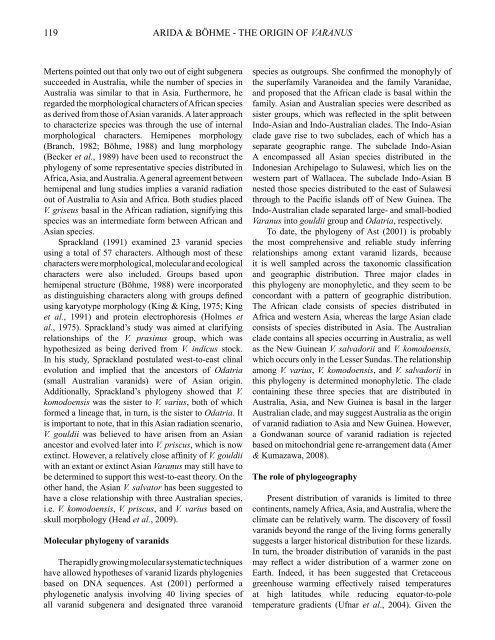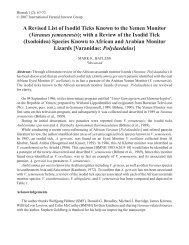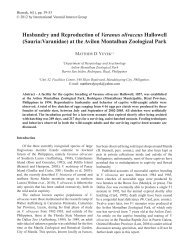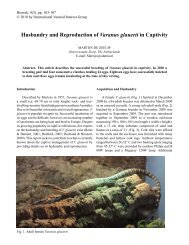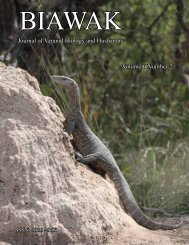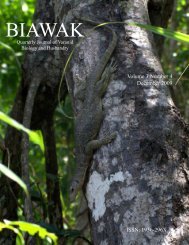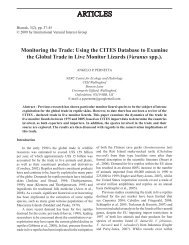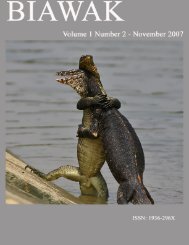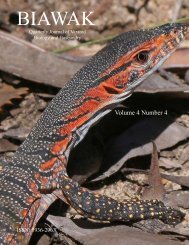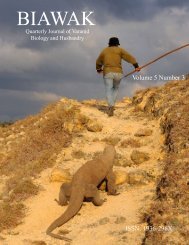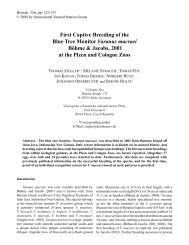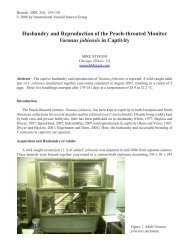BIAWAK - International Varanid Interest Group
BIAWAK - International Varanid Interest Group
BIAWAK - International Varanid Interest Group
- No tags were found...
You also want an ePaper? Increase the reach of your titles
YUMPU automatically turns print PDFs into web optimized ePapers that Google loves.
119<br />
ARIDA & BÖHME - THE ORIGIN OF VARANUS<br />
Mertens pointed out that only two out of eight subgenera<br />
succeeded in Australia, while the number of species in<br />
Australia was similar to that in Asia. Furthermore, he<br />
regarded the morphological characters of African species<br />
as derived from those of Asian varanids. A later approach<br />
to characterize species was through the use of internal<br />
morphological characters. Hemipenes morphology<br />
(Branch, 1982; Böhme, 1988) and lung morphology<br />
(Becker et al., 1989) have been used to reconstruct the<br />
phylogeny of some representative species distributed in<br />
Africa, Asia, and Australia. A general agreement between<br />
hemipenal and lung studies implies a varanid radiation<br />
out of Australia to Asia and Africa. Both studies placed<br />
V. griseus basal in the African radiation, signifying this<br />
species was an intermediate form between African and<br />
Asian species.<br />
Sprackland (1991) examined 23 varanid species<br />
using a total of 57 characters. Although most of these<br />
characters were morphological, molecular and ecological<br />
characters were also included. <strong>Group</strong>s based upon<br />
hemipenal structure (Böhme, 1988) were incorporated<br />
as distinguishing characters along with groups defined<br />
using karyotype morphology (King & King, 1975; King<br />
et al., 1991) and protein electrophoresis (Holmes et<br />
al., 1975). Sprackland’s study was aimed at clarifying<br />
relationships of the V. prasinus group, which was<br />
hypothesized as being derived from V. indicus stock.<br />
In his study, Sprackland postulated west-to-east clinal<br />
evolution and implied that the ancestors of Odatria<br />
(small Australian varanids) were of Asian origin.<br />
Additionally, Sprackland’s phylogeny showed that V.<br />
komodoensis was the sister to V. varius, both of which<br />
formed a lineage that, in turn, is the sister to Odatria. It<br />
is important to note, that in this Asian radiation scenario,<br />
V. gouldii was believed to have arisen from an Asian<br />
ancestor and evolved later into V. priscus, which is now<br />
extinct. However, a relatively close affinity of V. gouldii<br />
with an extant or extinct Asian Varanus may still have to<br />
be determined to support this west-to-east theory. On the<br />
other hand, the Asian V. salvator has been suggested to<br />
have a close relationship with three Australian species,<br />
i.e. V. komodoensis, V. priscus, and V. varius based on<br />
skull morphology (Head et al., 2009).<br />
Molecular phylogeny of varanids<br />
The rapidly growing molecular systematic techniques<br />
have allowed hypotheses of varanid lizards phylogenies<br />
based on DNA sequences. Ast (2001) performed a<br />
phylogenetic analysis involving 40 living species of<br />
all varanid subgenera and designated three varanoid<br />
species as outgroups. She confirmed the monophyly of<br />
the superfamily Varanoidea and the family <strong>Varanid</strong>ae,<br />
and proposed that the African clade is basal within the<br />
family. Asian and Australian species were described as<br />
sister groups, which was reflected in the split between<br />
Indo-Asian and Indo-Australian clades. The Indo-Asian<br />
clade gave rise to two subclades, each of which has a<br />
separate geographic range. The subclade Indo-Asian<br />
A encompassed all Asian species distributed in the<br />
Indonesian Archipelago to Sulawesi, which lies on the<br />
western part of Wallacea. The subclade Indo-Asian B<br />
nested those species distributed to the east of Sulawesi<br />
through to the Pacific islands off of New Guinea. The<br />
Indo-Australian clade separated large- and small-bodied<br />
Varanus into gouldii group and Odatria, respectively.<br />
To date, the phylogeny of Ast (2001) is probably<br />
the most comprehensive and reliable study inferring<br />
relationships among extant varanid lizards, because<br />
it is well sampled across the taxonomic classification<br />
and geographic distribution. Three major clades in<br />
this phylogeny are monophyletic, and they seem to be<br />
concordant with a pattern of geographic distribution.<br />
The African clade consists of species distributed in<br />
Africa and western Asia, whereas the large Asian clade<br />
consists of species distributed in Asia. The Australian<br />
clade contains all species occurring in Australia, as well<br />
as the New Guinean V. salvadorii and V. komodoensis,<br />
which occurs only in the Lesser Sundas. The relationship<br />
among V. varius, V. komodoensis, and V. salvadorii in<br />
this phylogeny is determined monophyletic. The clade<br />
containing these three species that are distributed in<br />
Australia, Asia, and New Guinea is basal in the larger<br />
Australian clade, and may suggest Australia as the origin<br />
of varanid radiation to Asia and New Guinea. However,<br />
a Gondwanan source of varanid radiation is rejected<br />
based on mitochondrial gene re-arrangement data (Amer<br />
& Kumazawa, 2008).<br />
The role of phylogeography<br />
Present distribution of varanids is limited to three<br />
continents, namely Africa, Asia, and Australia, where the<br />
climate can be relatively warm. The discovery of fossil<br />
varanids beyond the range of the living forms generally<br />
suggests a larger historical distribution for these lizards.<br />
In turn, the broader distribution of varanids in the past<br />
may reflect a wider distribution of a warmer zone on<br />
Earth. Indeed, it has been suggested that Cretaceous<br />
greenhouse warming effectively raised temperatures<br />
at high latitudes while reducing equator-to-pole<br />
temperature gradients (Ufnar et al., 2004). Given the


